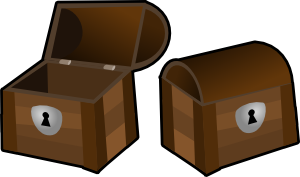 Why couldn’t the pirate play cards? Because he was standing on the deck!
Why couldn’t the pirate play cards? Because he was standing on the deck!
Playing cards is another way to practice math. If 2 people are playing, divide the deck in 2 halves. Each player takes half, all cards in a pile face down. Pirates, of course, like lots of treasure. Each player turns over the top card and the one with the higher number takes both cards. If both cards are the same, players need to turn over another card each. More than 2 people can play. If more than 4 are playing, use 2 decks of cards. In this game it doesn’t matter if some of the cards have different backs. The pirates do not mind.
Young toddlers may not be able to name the numbers, only see that some cards have more items. A little bit older ones may need to count to recognize the written numeral. Some may be able to read the numerals. Pirates who have strong math skills may be able to just look at the cards and know how many. This ability to know how many items there are without counting and without looking at the numeral is called subitizing. It’s easy to do for 1, 2, 3 and 4 objects in a group, but gets harder after that. Card games are a fun way to practice math skills, and social skills. Learning how to both win and lose is another skill that take practice. (Pirates really need to practice the not winning part. )
What other card games do pirates play?

 Pirates should be pretty good at math, one would guess. After all, think of all the counting they have to do: counting their loot, measuring how many steps before burying their treasure, knowing four (fore) and halft, working on the quarter deck, etc. Today, put on your pirate hats and count. How many steps is it to the kitchen? How many kids are needed to swab the decks? How many stuffies are on the captain’s bed? Treasures have to get picked up off the floor before they get tucked away in the toy box trunk. For mates that are ready for more than counting, do some mores. Are there more socks to get put away or are there more pants? Are there more plates or more cups to wash?
Pirates should be pretty good at math, one would guess. After all, think of all the counting they have to do: counting their loot, measuring how many steps before burying their treasure, knowing four (fore) and halft, working on the quarter deck, etc. Today, put on your pirate hats and count. How many steps is it to the kitchen? How many kids are needed to swab the decks? How many stuffies are on the captain’s bed? Treasures have to get picked up off the floor before they get tucked away in the toy box trunk. For mates that are ready for more than counting, do some mores. Are there more socks to get put away or are there more pants? Are there more plates or more cups to wash? Pirates sail on the deep blue sea, deep blue sea, deep blue sea.
Pirates sail on the deep blue sea, deep blue sea, deep blue sea.